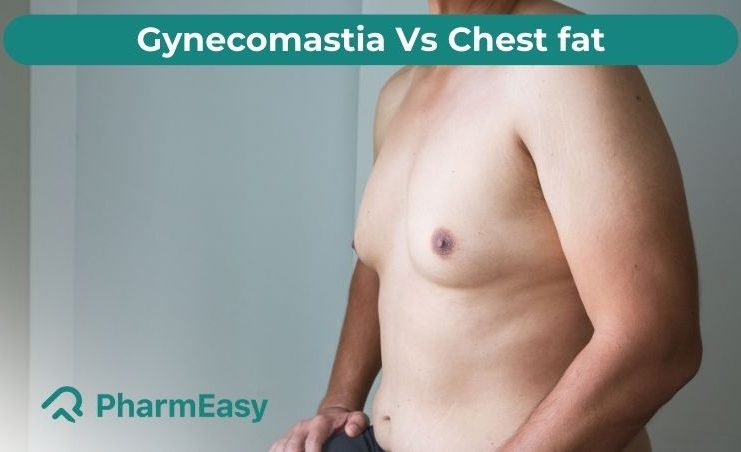Difference Between Gynecomastia And Chest Fat
By Saksham Bhatia +2 more

Get more insightful and
helpful tips to
treat Diabetes for FREE



Download PharmEasy App




Register to Avail the Offer
Send OTPBy continuing, you agree with our Privacy Policy and Terms and Conditions
By Saksham Bhatia +2 more
Table of Contents
Gynecomastia is also referred to as ‘man boobs’; it is a common condition in which the breasts In men enlarge and appears bigger in size. It is mainly caused due to an imbalance of the hormones estrogen and testosterone. Gynecomastia can affect one or both breasts, it isn’t a serious problem, but it can sometimes lead to pain in the breasts and the affected person may feel embarrassed or uncomfortable with his appearance. Gynecomastia may go away on its own or require medication and surgery.

Did you know?
Also Read: How to Get Rid of Man Boobs: Effective Strategies from Expert Studies
Chest fat is also known as pseudo-gynecomastia; it happens when excess fat gets accumulates in the chest, giving men the appearance of ‘man boobs’. Sometimes, chest fat occurs due to a health condition.
Puberty is a common age group when gynecomastia usually manifests. If you feel that it isn’t subsiding on its own within 6 months to 2 years, you may consult a physician to get it thoroughly examined and rule out other causes beyond hormonal changes.
Dr Ashish Bajaj – M.B.B.S, M.D. in Clinical Pharmacology and Toxicology
Table of differences between Gynecomastia and Chest Fat
| Different Factors | Gynecomastia | Chest Fat |
| Causes | Decrease in the hormone testosterone compared with estrogen in men. Gynecomastia in infants by birth due to the effects of their mother’s estrogen. Gynecomastia during puberty. A number of medications like anti-androgens, anabolic steroids, anti-anxiety, heart medications and antibiotics can cause gynecomastia. Chemotherapy to treat cancer. Recreational drugs and alcohol Ageing. Hormone changes that occur with ageing can cause gynecomastia Obesity. Tumors. Hyperthyroidism. When the thyroid gland produces too much of the hormone thyroxine. Kidney failure. People undergoing dialysis may experience gynecomastia. Liver failure and cirrhosis. Malnutrition and starvation. | Ageing. Due to the loss of muscle tissue, a person will have more body fat. A sedentary lifestyle Unhealthy diet Lack of exercise Menopause in women and hormonal changes during pregnancy. Obesity Drugs Genetics Health conditions like liver and kidney disease lung or testicular cancer thyroid disorder cystic fibrosis |
| Symptoms | Pain in and around the breasts Swollen breast tissue Firm to the touch, feels hard like a lump under the skin Gynecomastia tends to be rounder and more proportioned, similar to a woman’s breasts. Breast tenderness Nipple sensitivity due to rubbing against clothes Nipple discharge in one or both breasts | Chest fat is soft to the touch Chest fat looks saggy or droopy and does not have a very defined shape. The nipple may project more than the rest of the chest. No nipple discharge. |
| Diagnosis | Review of your symptoms Blood tests Mammograms Computerized tomography (CT) scans Magnetic resonance imaging (MRI) scans Testicular ultrasounds Tissue biopsies | Physical examination of the texture of your chest |
| Treatment options that can be advised by doctors | Most cases of gynecomastia resolve over time without treatment. However, if it is caused by an underlying condition, these are the possible treatments: Medications used to treat breast cancer and other conditions may be helpful for some men with gynecomastia. Two types of gynecomastia surgery options are Liposuction. This surgery removes breast fat but not the breast gland tissue itself. Mastectomy. This type of surgery removes the breast gland tissue by using only small incisions. | Healthy diet and exercise Liposuction. |
| Prevalence | Gynecomastia is prevalent among men aged 50 – 80. | It can occur at any age, affecting both men and women. |
| Complications | Untreated Gynecomastia may slightly increase your risk of breast cancer. Underlying health conditions may worsen without treatment. | If chest fat is not treated, it may affect your mental health as you experience a lack of confidence It may cause other health problems |
During pubertal development, gynecomastia can develop as a result of transient relative imbalances between androgens and estrogens. Pubertal gynecomastia is self-limited in 75 to 90% of adolescents and regresses over 1 to 3 years. However, it may cause significant psychological stress and depression in adolescents.
Dr. M.G. Kartheeka – MBBS, MD(Pediatrics)
Gynecomastia and chest fat are both very similar conditions and it is possible for you to confuse two. If you notice any abnormal changes in your chest, you must consult a doctor at the earliest. Timely diagnosis and proper treatment will ensure that your condition leads to no serious complications. Avoid self-medicating as it can worsen these two conditions.
Disclaimer: The information included on this site is for educational purposes only and is not intended to be a substitute for medical treatment by a healthcare professional. Because of unique individual needs, the reader should consult their physician to determine the appropriateness of the information for the reader’s situation.
Comments